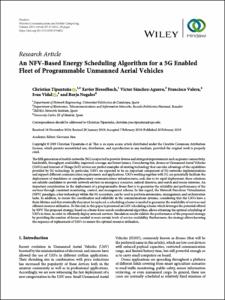Mostra el registre d'ítem simple
An NFV-based energy scheduling algorithm for a 5G enabled fleet of programmable unmanned aerial vehicles
| dc.contributor.author | Tipantuña Tenelema, Christian José |
| dc.contributor.author | Hesselbach Serra, Xavier |
| dc.contributor.author | Sánchez Aguero, Víctor |
| dc.contributor.author | Valera Pintor, Francisco |
| dc.contributor.author | Vidal Fernández, Iván |
| dc.contributor.author | Nogales Dorado, Borja |
| dc.contributor.other | Universitat Politècnica de Catalunya. Departament d'Enginyeria Telemàtica |
| dc.date.accessioned | 2019-03-19T18:52:24Z |
| dc.date.available | 2019-03-19T18:52:24Z |
| dc.date.issued | 2019-01-01 |
| dc.identifier.citation | Tipantuña, C. [et al.]. An NFV-based energy scheduling algorithm for a 5G enabled fleet of programmable unmanned aerial vehicles. "Wireless communications and mobile computing", 1 Gener 2019, vol. 2019, p. 4734821-1-4734821-20. |
| dc.identifier.issn | 1530-8669 |
| dc.identifier.uri | http://hdl.handle.net/2117/130633 |
| dc.description.abstract | The fifth generation of mobile networks (5G) is expected to provide diverse and stringent improvements such as greater connectivity, bandwidth, throughput, availability, improved coverage, and lower latency. Considering this, drones or Unmanned Aerial Vehicles (UAVs) and Internet of Things (IoT) devices are perfect examples of existing technology that can take advantage of the capabilities provided by 5G technology. In particular, UAVs are expected to be an important component of 5G networks implementations and support different communication requirements and applications. UAVs working together with 5G can potentially facilitate the deployment of standalone or complementary communications infrastructures, and, due to its rapid deployment, these solutions are suitable candidates to provide network services in emergency scenarios, natural disasters, and search and rescue missions. An important consideration in the deployment of a programmable drone fleet is to guarantee the reliability and performance of the services through consistent monitoring, control, and management scheme. In this regard, the Network Functions Virtualization (NFV) paradigm, a key technology within the 5G ecosystem, can be used to perform automation, management, and orchestration tasks. In addition, to ensure the coordination and reliability in the communications systems, considering that the UAVs have a finite lifetime and that eventually they must be replaced, a scheduling scheme is needed to guarantee the availability of services and efficient resource utilization. To this end, in this paper is presented an UAV scheduling scheme which leverages the potential offered by NFV. The proposed strategy, based on a brute-force search combinatorial algorithm, allows obtaining the optimal scheduling of UAVs in time, in order to efficiently deploy network services. Simulation results validate the performance of the proposed strategy, by providing the number of drones needed to meet certain levels of service availability. Furthermore, the strategy allows knowing the sequence of replacement of UAVs to ensure the optimal resource utilization. |
| dc.language.iso | eng |
| dc.rights | Attribution-NonCommercial-NoDerivs 3.0 Spain |
| dc.rights.uri | http://creativecommons.org/licenses/by-nc-nd/3.0/es/ |
| dc.subject | Àrees temàtiques de la UPC::Enginyeria de la telecomunicació::Radiocomunicació i exploració electromagnètica::Comunicacions mòbils |
| dc.subject.lcsh | Mobile communication systems |
| dc.title | An NFV-based energy scheduling algorithm for a 5G enabled fleet of programmable unmanned aerial vehicles |
| dc.type | Article |
| dc.subject.lemac | Comunicacions mòbils, Sistemes de |
| dc.contributor.group | Universitat Politècnica de Catalunya. BAMPLA - Disseny i Avaluació de Xarxes i Serveis de Banda Ampla |
| dc.identifier.doi | 10.1155/2019/4734821 |
| dc.description.peerreviewed | Peer Reviewed |
| dc.relation.publisherversion | https://www.hindawi.com/journals/wcmc/2019/4734821/ |
| dc.rights.access | Open Access |
| local.identifier.drac | 24006165 |
| dc.description.version | Postprint (published version) |
| dc.relation.projectid | info:eu-repo/grantAgreement/MINECO/1PE/TEC2016-76795-C6-1-R |
| local.citation.author | Tipantuña, C.; Hesselbach, X.; Sánchez, V.; Valera , F.; Vidal, I.; Nogales, B. |
| local.citation.publicationName | Wireless communications and mobile computing |
| local.citation.volume | 2019 |
| local.citation.startingPage | 4734821-1 |
| local.citation.endingPage | 4734821-20 |
Fitxers d'aquest items
Aquest ítem apareix a les col·leccions següents
-
Articles de revista [128]
-
Articles de revista [482]


